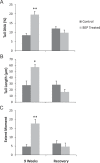Exposure to bleomycin, etoposide, and cis-platinum alters rat sperm chromatin integrity and sperm head protein profile
- PMID: 22402960
- PMCID: PMC4480069
- DOI: 10.1095/biolreprod.111.098616
Exposure to bleomycin, etoposide, and cis-platinum alters rat sperm chromatin integrity and sperm head protein profile
Abstract
Testicular cancer, currently the most common cancer affecting men of reproductive age, is one of the most curable malignancies due to the progress made in the early diagnosis and effective treatment of this disease. The coadministration of bleomycin, etoposide, and cis-platinum (BEP) has brought the 5-yr survival rate of testis cancer patients to over 90%. However, this treatment results in reproductive chemotoxic effects. We assessed the effect of BEP treatment on sperm chromatin integrity and sperm head protein profiles of adult male Brown Norway rats following 9 wk of treatment with BEP and in animals treated for 9 wk and then subjected to a 9-wk recovery period. Both the susceptibility of DNA to denaturation and the number of strand breaks were significantly increased in mature sperm following 9 wk of treatment with BEP; proteomic analysis revealed that the expression of several proteins, including HSP90AA1 and HSP90B1, was markedly affected. Following a 9-wk recovery period, mature sperm did not show significant DNA damage, indicating that repair had potentially occurred. Interestingly, the protamination level of the sperm of these animals was significantly decreased, while histones HIST1H1D (H1.2), HIST1H4B (H4), HIST2H2AA3 (H2A1), and HIST1H2BA (H2B1A) were concomitantly up-regulated; this was not observed in the sperm immediately following 9 wk of treatment. Thus, there are persistent effects on proteins in sperm heads from the cauda epididymidis 9 wk posttreatment, in the absence of DNA strand breaks. We suggest that these effects on the sperm head proteome may contribute to long-lasting adverse effects in the progeny of BEP-exposed males.
Figures





Similar articles
-
The effects of chemotherapy with bleomycin, etoposide, and cis-platinum (BEP) on rat sperm chromatin remodeling, fecundity and testicular gene expression in the progeny.Biol Reprod. 2013 Oct 10;89(4):85. doi: 10.1095/biolreprod.113.110759. Print 2013 Oct. Biol Reprod. 2013. PMID: 23986570
-
Paternal exposure to testis cancer chemotherapeutics alters sperm fertilizing capacity and affects gene expression in the eight-cell stage rat embryo.Andrology. 2014 Mar;2(2):259-66. doi: 10.1111/j.2047-2927.2014.00185.x. Epub 2014 Jan 29. Andrology. 2014. PMID: 24478030
-
Protective effects of zinc on rat sperm chromatin integrity involvement: DNA methylation, DNA fragmentation, ubiquitination and protamination after bleomycin etoposide and cis-platin treatment.Theriogenology. 2020 Jan 15;142:177-183. doi: 10.1016/j.theriogenology.2019.09.039. Epub 2019 Sep 25. Theriogenology. 2020. PMID: 31600638
-
Intensive induction chemotherapy with CBOP/BEP in patients with poor prognosis germ cell tumors.J Clin Oncol. 2003 Mar 1;21(5):871-7. doi: 10.1200/JCO.2003.05.155. J Clin Oncol. 2003. PMID: 12610187 Review.
-
Sperm chromatin protamination: an endocrine perspective.Protein Pept Lett. 2011 Aug;18(8):786-801. doi: 10.2174/092986611795714005. Protein Pept Lett. 2011. PMID: 21443490 Review.
Cited by
-
Therapeutic effect of sodium alginate on bleomycin, etoposide and cisplatin (BEP)-induced reproductive toxicity by inhibiting nitro-oxidative stress, inflammation and apoptosis.Sci Rep. 2024 Jan 18;14(1):1565. doi: 10.1038/s41598-024-52010-w. Sci Rep. 2024. PMID: 38238398 Free PMC article.
-
The etiologies of DNA abnormalities in male infertility: An assessment and review.Int J Reprod Biomed. 2017 Jun;15(6):331-344. Int J Reprod Biomed. 2017. PMID: 29177237 Free PMC article. Review.
-
Exposure to Chemotherapy During Childhood or Adulthood and Consequences on Spermatogenesis and Male Fertility.Int J Mol Sci. 2020 Feb 20;21(4):1454. doi: 10.3390/ijms21041454. Int J Mol Sci. 2020. PMID: 32093393 Free PMC article. Review.
-
The Effects of Chemotherapeutic Agents, Bleomycin, Etoposide, and Cisplatin, on Chromatin Remodeling in Male Rat Germ Cells.Biol Reprod. 2016 Apr;94(4):81. doi: 10.1095/biolreprod.115.137802. Epub 2016 Feb 24. Biol Reprod. 2016. PMID: 26911428 Free PMC article.
-
Protective effect of royal jelly on fertility and biochemical parameters in bleomycin-induced male rats.Iran J Reprod Med. 2014 Mar;12(3):209-16. Iran J Reprod Med. 2014. PMID: 24799882 Free PMC article.
References
-
- Bray F, Richiardi L, Ekbom A, Pukkala E, Cuninkova M, Moller H. Trends in testicular cancer incidence and mortality in 22 European countries: continuing increases in incidence and declines in mortality. Int J Cancer 2006; 118: 3099 3111. - PubMed
-
- Huyghe E, Matsuda T, Thonneau P. Increasing incidence of testicular cancer worldwide: a review. J Urol 2003; 170: 5 11. - PubMed
-
- Einhorn LH, Foster RS. Bleomycin, etoposide, and cisplatin for three cycles compared with etoposide and cisplatin for four cycles in good-risk germ cell tumors: is there a preferred regimen? J Clin Oncol 2006; 24: 2597 2598; author reply 2598–2599. - PubMed
-
- Huddart RA, Birtle AJ. Recent advances in the treatment of testicular cancer. Expert Rev Anticancer Ther 2005; 5: 123 138. - PubMed
Publication types
MeSH terms
Substances
Grants and funding
LinkOut - more resources
Full Text Sources
Miscellaneous

